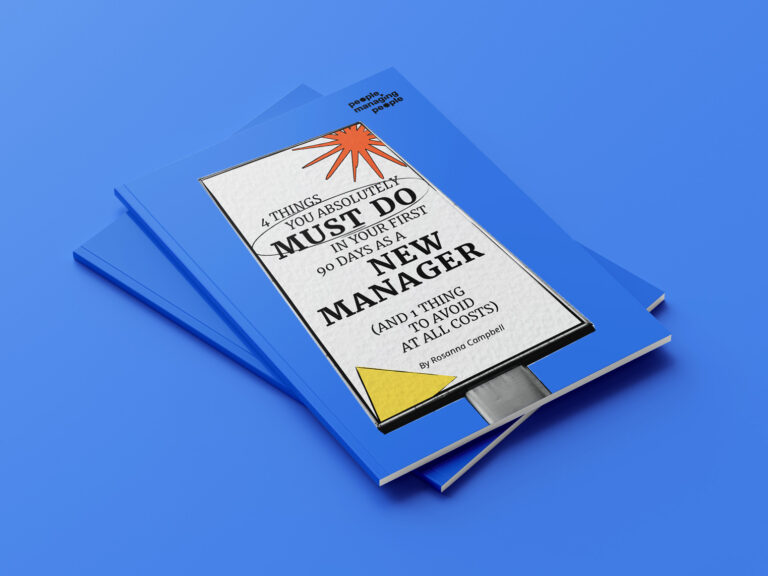When you applied for a management job, you knew it would be a challenge. But you felt confident that you were up to it.
When the interview panel asked you to describe a situation where you had to cope with stress, your answer convinced them you would be a calm leader. So they gave you the position and put you in charge of your team.
So how is it that you already feel overwhelmed?
On your first day, you told your team “My door is always open”. Now, there’s a constant line down the hall.
You’re bouncing from meeting to Zoom call to meeting. Your inbox and your to-do list are backing up. You can’t quite get a handle on the new team dynamics. You’re noticing hints of a brewing conflict.
Not to mention, there’s a major project deadline looming.
How can you keep calm and carry on when you feel like you’re in too deep?
In this article, we’ll look at why we get overwhelmed and how overwhelm affects us, our work, and our teams.
We’ll look at the characteristics of a calm leader and give you 5 practical approaches to your new position that will help you keep calm and carry on (even when you’re overwhelmed).
The impact of overwhelm
We’re not going to lie—being a new manager can be incredibly stressful. There will be challenges. There will be conflicts. Crises will happen. That’s the nature of being a manager.
Stress is not always a bad thing. In fact, it can even be a positive motivator that pushes you to achieve. Too much stress, however, can lead to overwhelm and even burnout. It depletes your ability to be able to cope well with challenges, so that the more overwhelmed you feel, the more overwhelming your challenges become. It’s a vicious circle.
A Harvard Business Review study found that, under pressure, 53% of leaders are more closed-minded and controlling. 45% of stressed leaders ignore or reject employees’ input. In another study, more than half of respondents felt that a manager who can’t handle stress effectively is harmful to the organization's performance.
What this means is you have a duty to be a calm leader.
Now, if you’re thinking that sounds impossible, don’t worry. It’s really just another management skill to work on.
What does a calm leader look like?

Calm leaders are simply those who know how to harness the power of their intuition, experience, maturity, and wisdom to be a more effective leader.
Doug Dickerson, leadership expert
Leadership trainer and arbitrator Doug Dickerson identifies the four key attributes of calm leaders:
- They see the bigger picture
- They know when to act and when to wait
- They challenge the standard ways of doing things
- They provide much-needed stability in trying times.
They’ve also developed a core skill set to help spread their calm to the rest of the team:
They have a calm, assertive communication style
It’s no good facing challenging times calmly if you don’t communicate your plan clearly, confidently and effectively. Calm leaders use an assertive but compassionate approach to communication.
They inspire resilience and stress management in others
If stress can be contagious, so can handling stress well. In fact, 79% of employees with a manager adept at management stress aspire to progression within the company, as opposed to just 55% of those with less resilient leaders.
Developing this skill set comes down to 5 key habits:
- Practicing self-compassion
- Taking a mindful pause before acting
- Learning to ask for help
- Single-tasking
- Delegating effectively.
How to develop your skills as a calm leader (even when you feel overwhelmed)
1. Go easy on yourself
This first step is all-important: be kind to yourself. Being a manager is a big responsibility, but it’s also a process. Becoming a great manager is something everyone has to work at—it’s not a skill that comes naturally.
To grow your skills as a calm leader, you need to accept that you have a lot to learn-and that’s absolutely fine. Start with a self-compassionate mindset.
Action points:
- Practice self-care in the workplace. Make a point of looking after your physical, mental, emotional, and social well-being. For instance, if you’re getting stressed, take a short break from your desk and head outside for a walk. Build pauses into your work day to stretch, exercise, or even meditate.
- Be aware of self-judgment and negative self-talk and nip it in the bud. Ask yourself, “Would I give my direct report this kind of feedback?” If the answer is no, then stop talking to yourself that way.
- Keep a “Wins” file. Set up a document on Google Drive and add in any positive feedback you receive from your managers, team, mentors or clients. Open it up on a bad day and remind yourself that you’ve come a long way.
- If you need a reminder, read Jo Small’s letter that begins: “Dear frazzled manager, You’re doing a tremendous job…”
2. Don’t rush; reflect
It’s vital not to rush into action, especially when you’re facing a crisis. Harvard Business School professor Nancy Koehn points to the example of Abraham Lincoln, who made a point of reacting to high-stakes situations by doing… nothing.
By allowing himself the time to reflect and assess the situation, Lincoln could come up with a more considered and grounded plan than if he had rushed headlong into action.
Koehn says: “The smallest pause before picking up the phone, sending out the tweet, or saying something to someone will help a leader gather his or her thoughts and maximize the chances that he or she makes a smart move.”
McKinsey researchers Jacqueline Brassey and Michiel Kruyt call this skill integrative awareness—the process of connecting your awareness of the situation with awareness of yourself and your responses.
By taking a mindful pause before responding, you can process your stress, cultivate a deliberate calm, and create the space to make clear-minded decisions and responses.
Action points:
- Schedule in time to think. At the beginning and the end of each week, set aside a time slot to review your performance as a manager and identify your trigger points. If you experienced overwhelm, what was the root cause and how can you reduce the chances you’ll feel that way again? What were the points where things went well?
- Consider establishing a mindfulness practice. Even a few minutes of meditation during the workday can help you pause before you react.
3. Ask for help
No matter what, all of us are going to be faced with issues that are beyond us. But it’s important not to let pride get in the way of asking for help.
Whether from co-workers or your own boss, it’s okay to seek support—especially if you’re a new manager. Despite what you might think, people are far more likely to want to help you than to judge you for asking.
“When you're right at the edge of your comfort zone,” says Kane Carpenter, Practice Lead of Employer Branding & Growth Strategies at Daggerfinn, “it's OK to try and figure something out yourself. When you feel like you are out of your depth completely, then it's time to ask for help.”
Action points:
- When you ask for help, be open, honest and specific about what you’re finding difficult. Show what you’ve already attempted, offer a potential solution or two, and ask for feedback.
- Prepare what you want to say ahead of time, and frame it in a positive way.
- Find a mentor outside your own organization, so you can discuss issues and challenges without worrying about looking like you can’t cope.
4. Do one thing at a time
The ability to multitask is often worn as a badge of honor. But multitasking isn't as productive as we think. It slows us down, keeps us distracted, and increases the likelihood that we will make mistakes. On top of that, research shows that we tend to badly inflate our ability to multitask.
By doing one thing at a time, we can focus on doing each thing well, and keep from feeling snowed under. In his book, Full Catastrophic Living, mindfulness expert John Kabat-Zinn advises:
"Try doing one thing at a time and giving it the attention it deserves for as long as it deserves, without distracting yourself or allowing yourself to be distracted, such as by incoming emails or texts."
Action points:
- Prioritize your task list, and then take each task in order, one at a time.
- Distinguish between what’s important and what’s urgent, and decide what you need to do first, what you can do later, and what you can delegate.
- Try out a prioritization tool like the Eisenhower Matrix.
- Digital task managers like Todoist or Trello can help you and your team organize your project tasks effectively.
5. Delegate
Don’t try to go it alone. You’re still part of a team, but you aren’t simply an individual contributor anymore. Delegation allows you the space to focus on your managerial priorities. It gives you the time to decompress and develop yourself as a manager.
As an added bonus, it also helps your staff to develop and learn new skills and competencies.
Action points:
- Take the time to map out all of your tasks. Identify which actions can or should only be done by you. Anything else that could be done by another member of the team, delegate (even if you feel you could do it better!)
- Consider the roles, aptitudes and existing workload of team members before delegating. This way you'll not only ensure quality, you'll also avoid simply shifting your overwhelm onto your direct reports.
Keep calm and carry on
Being a calm leader doesn’t mean you deny the challenges of management, or pretend they’re not challenging. It simply means choosing how best to respond. It’s about acceptance and action, not reaction.
You don’t have to wait to qualify as a “calm leader”. Just like Lincoln, you can choose to act calmly. The nice thing about acting like a calm leader is that it actually helps you to become a calm leader. Best of luck!

The New Manager Handbook
Hard-learned words of wisdom from seasoned people managers to those just starting out.
Beyond the handbook, if you're hoping for additional help in honing your skills and building your techniques for life with direct reports, you'll want to consider a new manager course for additional training.
Some further resources to help you on your management journey:
- Why You Shouldn’t Be Afraid To Ask For Help As A New Manager (and How to Do It)
- How To Handle Awkward And Uncomfortable Conversations: What Every New Manager Should Know
- From Friend To Boss: How To Establish Authority & Set Boundaries As A New Manager
- People Management Tips For New And Experienced Managers
- 5 Methods To Help You Deal With Difficult Team Members
- How To Go From Manager To Coach
- Clarity, Responsibility, And Accountability (CRA) Model Of Leadership
- Unlearning Leadership: How To Lead In The New World Of Work (with Bev Attfield from Within People)
- 10 Best Leadership Development Programs to Grow Future Leaders




